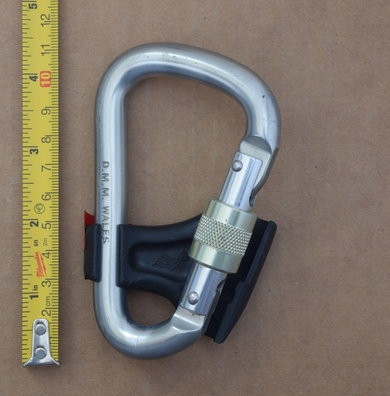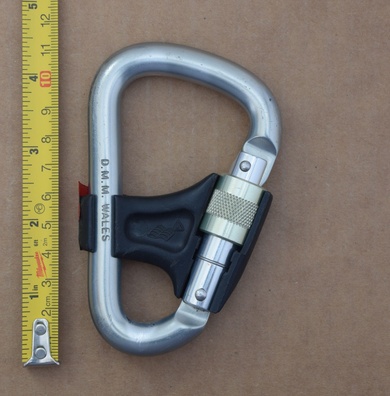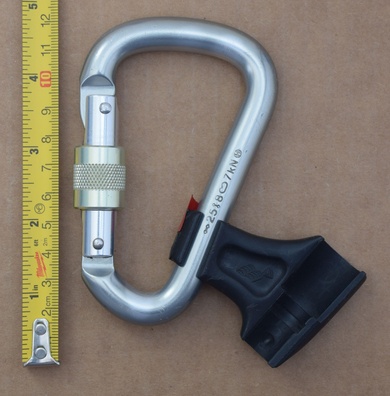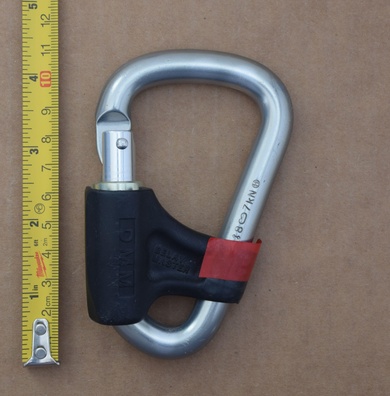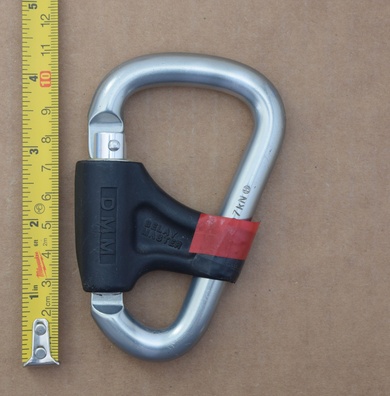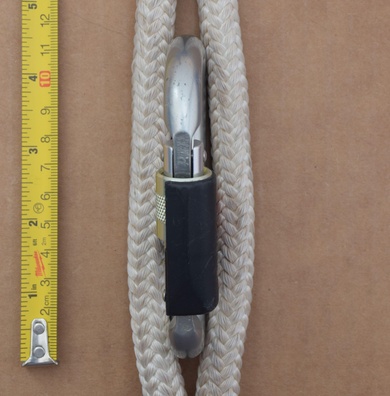| Name: | DMM Belay Master (v1) |
| Category: | screw lock |
| Locking Type: | manual |
| Locks: | screw |
| Unlock Style: | gate stopped |
| Sleeve Rotation: | 900° (unlocked) | 1470° (maximum) |
| Shape: | HMS |
| Material: | aluminum |
| Profile: | round |
| Nose: | notch & pin |
| Nose Guard: | none |
| Rivets: | domed |
| Gate Shield: | semi |
| Anti Crossload: | side gate |
| Weight: | 97 g |
| Dimensions: | Length: 109 mm Width: 68 mm Gate Opening: 18 mm |
| Strength Ratings: |  25 kN | 25 kN |  8 kN | 8 kN |  7 kN 7 kN |
| Other Markings: | Rollmarked: D.M.M. WALES | (ratings) Ⓗ Stamped: 0120 CE ACZ Injection Molded: DMM BELAY MASTER  |
| Batch Marking Location: | spine-exterior |
| Collection Criteria: | ★ Personal Favorite |
| Summary: | early belay specific carabiner, side-gate anti-crossload |
| Description & Commentary: | The original side-gate anti-crossload belay carabiner. This carabiner is essentially a DMM Fatboy with a molded (moulded I suppose since this is DMM) nylon crosspiece attached to the carabiner spine. The crosspiece pivots about the spine, and will snap onto the gate when the locking sleeve is in the fully locked position, acting as a (side-opening) gate restricting movement between the carabiner's basket end and runner end (hinge end). DMM calls this crosspiece the "Belay Master Clip." The hinge of the side gate slides along the carabiner spine, and must be positioned centrally to snap into position - a slight annoyance. Newer designs employ a recessed section on the spine to prevent this issue. Outside of the nylon side-gate, the itself carabiner is unremarkable - a pin and notch gate latch, nicely finished with smooth acting locking sleeve and well shielded gate (somewhat irrelevant as this should only shred rope if the carabiner was crossloaded, which this carabiner is explicitly designed to avoid). In practice, I have found that the side gate occasionally unsnaps from the gate when belaying with a modern stiff-cabled belay device such as a Black Diamond ATC-XP. The cable pushes the side-gate open when the device is loaded. Some of the older (or lower quality) devices with smaller, more flexible cables do not present the same issue, but they are more prone to have the cable sucked up into the device, possibly jamming the rope! Since the side-gate cannot be closed without fully locking the carabiner, it provides an additional large visual cue if the carabiner is unlocked. Ultimately, I consider this the single greatest benefit of side-gated anti-crossload carabiners. I bought and used this carabiner during an era when mechanical belay devices were uncommon and used it entirely with traditional slotted-tube devices. In part driven by the prevelance of smaller ropes, explosion in gym climbing, and improvements in the design, mechanical belay devices (and locking-assist devices such as the Click-Up) are now common in all climbing settings. This has also ushered in a new era of anti-crossload carabiners. Crossloading is only a minor strength issue when belaying off of a harness, but it can bind up a belay device or make a device more challenging to use. With mechanical devices, maintaining proper orientation increases the reliability of the catch, and reduces binding/improper loading from these two hard linked pieces of rigid equipment. Moving a device from the basket into the captive end requires passing the 17.9 mm diameter locking sleeve (21.9 mm long). Personally, I like side-gated anti-crossload carabiners, especially the modern versions like the Belay Master v3 and Mammut Smart HMS. They provide a degree of additional security in ensuring the gate is locked, and are fully manual compared to internal wiregate designs - I can leave the side gate open until I need to fully close the device and engage the anti-crossload. It feels a bit like the difference between a screwgate carabiner and a simple double-action (single locking) twist-lock carabiner. One downside is that the carabiner takes on a third-dimension which may catch or snag on things when the side gate is left open. In practice I do not find this to be an issue, but could see some climbers to consider it an unnecessary hassle when we have so many alternative anti-crossload designs on the market today. |
| Technical Notice: | Technical Notice |
